I enjoy reading the life stories of individuals that focus on how their lives were shaped by the times and places in which they grew up. These are some of my favorite recently published biographies, written in various formats and covering different periods of history to the present. A common thread of these biographies is the importance of childhood experiences in lifetime achievements.
Ages 4–8
Ada Lovelace, Poet of Science: The First Computer Programmer. Diane Stanley. Ill. Jessie Hartland. 2016. Paula Wiseman/Simon & Schuster.
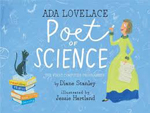 Lady Byron feared Ada had too much imagination. She wanted her daughter to be “calm and rational, not emotional and creative like her father [Lord Byron].” She hoped that having Ada study science and math would curb her wild imagination. An engaging narrative and witty gouache illustrations introduce readers to the life and accomplishments of Ada Byron Lovelace (1815–1852) who, at the age of 24, developed an algorithm for inventor Charles Babbage’s Analytical Engine, a calculating machine he had designed. Back matter includes an author’s note on Babbage’s invention and Lovelace’s algorithm, the first computer program ever published; a timeline; a bibliography; and a glossary.
Lady Byron feared Ada had too much imagination. She wanted her daughter to be “calm and rational, not emotional and creative like her father [Lord Byron].” She hoped that having Ada study science and math would curb her wild imagination. An engaging narrative and witty gouache illustrations introduce readers to the life and accomplishments of Ada Byron Lovelace (1815–1852) who, at the age of 24, developed an algorithm for inventor Charles Babbage’s Analytical Engine, a calculating machine he had designed. Back matter includes an author’s note on Babbage’s invention and Lovelace’s algorithm, the first computer program ever published; a timeline; a bibliography; and a glossary.
Charles Darwin’s Around-the-World Adventure. Jennifer Thermes. 2016. Abrams.
 Thermes’s picture book biography of Charles Darwin (1809–1882) focuses on the five-year voyage of the HMS Beagle, which began in 1831. Colorful, detailed watercolor-and-pencil illustrations depict Darwin’s journey of discovery in which he collected animals, plants, fossils, and rocks and recorded his observations in a journal. Numerous maps throughout the book chart the Beagle’s journey. A map and timeline of the departure route is on the front endpaper; the return is on the back endpaper. Back matter includes notes on how the voyage shaped Darwin’s ideas about evolution and the publication of The Origin of Species (1859), sources, suggestions for further reading, and a spread of “fun facts.”
Thermes’s picture book biography of Charles Darwin (1809–1882) focuses on the five-year voyage of the HMS Beagle, which began in 1831. Colorful, detailed watercolor-and-pencil illustrations depict Darwin’s journey of discovery in which he collected animals, plants, fossils, and rocks and recorded his observations in a journal. Numerous maps throughout the book chart the Beagle’s journey. A map and timeline of the departure route is on the front endpaper; the return is on the back endpaper. Back matter includes notes on how the voyage shaped Darwin’s ideas about evolution and the publication of The Origin of Species (1859), sources, suggestions for further reading, and a spread of “fun facts.”
Esquivel! Space-Age Sound Artist. Susan Wood. Ill. Duncan Tonatiuh. 2016. Charlesbridge.
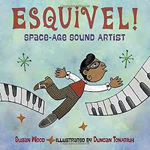 Juan García Esquivel (1918–2002), who discovered his love of music as a young child in Mexico, went on to a stellar career as an innovative composer, orchestra leader, and pioneer of stereo sound in the 1950s and 1960s. Both Wood’s lively text (“He might tell the trumpets and trombones to HONK! BLAP! BLEEP like blaring car horns.”) and Tonatiuh’s signature Mixtec codices-inspired illustrations are peppered with onomatopoeia, expressing the way in which Esquivel captured the sounds of the world around him in his music. Back matter includes an author’s note; an illustrator’s note; resources, including books and periodicals, websites, and videos; and a photograph of Esquivel.
Juan García Esquivel (1918–2002), who discovered his love of music as a young child in Mexico, went on to a stellar career as an innovative composer, orchestra leader, and pioneer of stereo sound in the 1950s and 1960s. Both Wood’s lively text (“He might tell the trumpets and trombones to HONK! BLAP! BLEEP like blaring car horns.”) and Tonatiuh’s signature Mixtec codices-inspired illustrations are peppered with onomatopoeia, expressing the way in which Esquivel captured the sounds of the world around him in his music. Back matter includes an author’s note; an illustrator’s note; resources, including books and periodicals, websites, and videos; and a photograph of Esquivel.
I Dissent: Ruth Bader Ginsburg Makes Her Mark. Debbie Levy. Ill. Elizabeth Baddeley. 2016. Simon & Schuster.
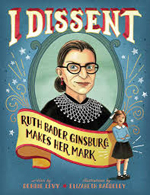 “You could say that Ruth Bader Ginsburg’s life has been...one disagreement after another.” This picture book biography chronicles the life and career of a determined young Jewish girl, who grew up in Brooklyn in the 1940s disagreeing with prejudice and objecting to limitations placed on girls. Against societal expectations, Ruth went to college and law school and became a law professor, and later a judge, all the time fighting for equality for everyone, while also being a wife and mother. In 1993, she was appointed by President Clinton to be a justice on the United States Supreme Court, where through her judicial opinions she often dissents. Back matter includes a “More About Ruth Bader Ginsburg” section, including photographs of Justice Ginsburg; notes on the Supreme Court cases mentioned in the text; and a bibliography.
“You could say that Ruth Bader Ginsburg’s life has been...one disagreement after another.” This picture book biography chronicles the life and career of a determined young Jewish girl, who grew up in Brooklyn in the 1940s disagreeing with prejudice and objecting to limitations placed on girls. Against societal expectations, Ruth went to college and law school and became a law professor, and later a judge, all the time fighting for equality for everyone, while also being a wife and mother. In 1993, she was appointed by President Clinton to be a justice on the United States Supreme Court, where through her judicial opinions she often dissents. Back matter includes a “More About Ruth Bader Ginsburg” section, including photographs of Justice Ginsburg; notes on the Supreme Court cases mentioned in the text; and a bibliography.
Six Dots: A Story of Young Louis Braille. Jen Bryant. Ill. Boris Kulikov. 2016. Alfred A. Knopf/Random House.
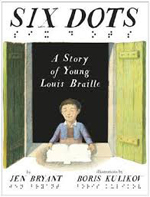 Left blind at the age of 5 by an accident and infection, Louis Braille attended the village school but wanted to read and write like other children. While attending the Royal School for the Blind in Paris, at the age of 15, he invented a reading and writing system for the blind by modifying a complex punched-paper military coding system into a six-dot alphabet system. Mixed-media illustrations, including some images done with blue lines on black backgrounds, complement the text of this biography, told from the perspective of young Louis. The front endpaper has a quote from Helen Keller, “We, the blind, are as indebted to Louis Braille as mankind is to Gutenberg,” written in Braille, and a chart of the Braille alphabet. Back matter includes an author’s note, a Q&A section, and references.
Left blind at the age of 5 by an accident and infection, Louis Braille attended the village school but wanted to read and write like other children. While attending the Royal School for the Blind in Paris, at the age of 15, he invented a reading and writing system for the blind by modifying a complex punched-paper military coding system into a six-dot alphabet system. Mixed-media illustrations, including some images done with blue lines on black backgrounds, complement the text of this biography, told from the perspective of young Louis. The front endpaper has a quote from Helen Keller, “We, the blind, are as indebted to Louis Braille as mankind is to Gutenberg,” written in Braille, and a chart of the Braille alphabet. Back matter includes an author’s note, a Q&A section, and references.
Ages 9–11
Finding Wonders: Three Girls Who Changed Science. Jeannine Atkins. 2016. Atheneum/Simon & Schuster.
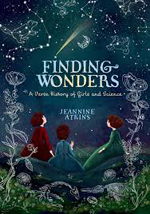 With spare lyrical poems, Atkins tells the stories of three women, born in three different countries in three different centuries, who made important contributions to science. As a child, Maria Sibylla Merian (1647–1717), born in Germany, was fascinated by insects. When she was not busy mixing paints for her artist father, she was collecting and observing insects. Maria is noted for her study of the metamorphosis of butterflies, at a time when people believed that caterpillars were shape-shifters who arose spontaneously from mud. Additionally, her naturalist paintings of insects were a major contribution to entomology. British Mary Anning (1799–1847) shared her father’s enthusiasm for fossil-collecting and discovered the first fossil of an ichthyosaur and other fossils that changed scientific ideas on prehistoric life. American Maria Mitchell (1818–1889), who grew up stargazing with her father, discovered a new comet in 1847, and was the first woman to be elected to the Academy of Arts and Science. Back matter includes an author’s note, a brief “Reading Past These Pages” essay by Atkins on biographies that influenced her writing of Finding Wonders, and a bibliography.
With spare lyrical poems, Atkins tells the stories of three women, born in three different countries in three different centuries, who made important contributions to science. As a child, Maria Sibylla Merian (1647–1717), born in Germany, was fascinated by insects. When she was not busy mixing paints for her artist father, she was collecting and observing insects. Maria is noted for her study of the metamorphosis of butterflies, at a time when people believed that caterpillars were shape-shifters who arose spontaneously from mud. Additionally, her naturalist paintings of insects were a major contribution to entomology. British Mary Anning (1799–1847) shared her father’s enthusiasm for fossil-collecting and discovered the first fossil of an ichthyosaur and other fossils that changed scientific ideas on prehistoric life. American Maria Mitchell (1818–1889), who grew up stargazing with her father, discovered a new comet in 1847, and was the first woman to be elected to the Academy of Arts and Science. Back matter includes an author’s note, a brief “Reading Past These Pages” essay by Atkins on biographies that influenced her writing of Finding Wonders, and a bibliography.
Radiant Child: The Story of Young Artist Jean-Michel Basquiat. Javaka Steptoe. 2016. Little, Brown.
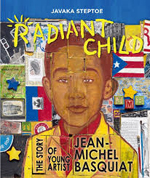 With a simple, lyrical text and expressive mixed-media illustrations, Javaka Steptoe has created a stunning biography of young artist Jean-Michel Basquiat (1960–1988). Early in his childhood, Jean-Michel was a serious and prolific artist, who dreamed of becoming a famous artist. His art was everywhere in his family’s home in Brooklyn. Moving to New York City in his teens, he painted on paper during the day and spray-painted walls downtown with poems and drawings at night. Gaining recognition, his collage paintings began to appear on art gallery walls. “People describe him as RADIANT, WILD, A GENIUS CHILD.” Back matter includes additional information on Jean-Michel Basquiat’s family, childhood experiences, success as a young artist, and death from a drug overdose at the age of 27; a note on motifs and symbolism in Basquiat’s work; and a note from Steptoe on his use of materials and motifs that Basquiat used in his artwork in creating the illustrations for this picture book biography of an artist who has inspired him.
With a simple, lyrical text and expressive mixed-media illustrations, Javaka Steptoe has created a stunning biography of young artist Jean-Michel Basquiat (1960–1988). Early in his childhood, Jean-Michel was a serious and prolific artist, who dreamed of becoming a famous artist. His art was everywhere in his family’s home in Brooklyn. Moving to New York City in his teens, he painted on paper during the day and spray-painted walls downtown with poems and drawings at night. Gaining recognition, his collage paintings began to appear on art gallery walls. “People describe him as RADIANT, WILD, A GENIUS CHILD.” Back matter includes additional information on Jean-Michel Basquiat’s family, childhood experiences, success as a young artist, and death from a drug overdose at the age of 27; a note on motifs and symbolism in Basquiat’s work; and a note from Steptoe on his use of materials and motifs that Basquiat used in his artwork in creating the illustrations for this picture book biography of an artist who has inspired him.
Ages 12–14
Florence Nightingale: The Courageous Life of the Legendary Nurse. Catherine Reef. 2016. Clarion/Houghton Mifflin Harcourt.
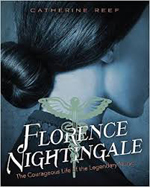 Florence Nightingale (1820–1910), best known as the compassionate Lady with the Lamp for her tireless efforts to improve the care of wounded soldiers in the Crimean War, was determined to become a nurse in spite of the expectations of her family and Victorian society for a privileged young woman. She went on to train nurse—to change hospitals into clean, comfortable, and healing places—to work with doctors and hospital administrators to provide better treatment for patients, and to work with government officials to improve community health standards. Reef presents a balanced portrait of Nightingale as intelligent, courageous, and caring while also being controlling, demanding, and uncompromising in her reform efforts. An abundance of quotations in the text and captioned archival photographs and prints add interest to this well-researched account of the life and work of Nightingale. Back matter includes source notes, an extensive bibliography, and an index.
Florence Nightingale (1820–1910), best known as the compassionate Lady with the Lamp for her tireless efforts to improve the care of wounded soldiers in the Crimean War, was determined to become a nurse in spite of the expectations of her family and Victorian society for a privileged young woman. She went on to train nurse—to change hospitals into clean, comfortable, and healing places—to work with doctors and hospital administrators to provide better treatment for patients, and to work with government officials to improve community health standards. Reef presents a balanced portrait of Nightingale as intelligent, courageous, and caring while also being controlling, demanding, and uncompromising in her reform efforts. An abundance of quotations in the text and captioned archival photographs and prints add interest to this well-researched account of the life and work of Nightingale. Back matter includes source notes, an extensive bibliography, and an index.
The Tudors: Kings, Queens, Scribes and Ferrets! Marcia Williams. 2016. Candlewick.
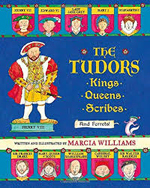 On the front endpaper, there is a note on the origin of this history of the Tudor Dynasty. According to Arthur Inkblott, before her death Queen Elizabeth I asked him, her favorite scribe, “to write down tales, both tragical and comical, from Tudor times.” A PS notes that there will be scenes from the lives of Tudor common folk along the bottom border and a PPS introduces Inkblott’s pet ferret, Smudge, who will be adding commentary in the margins of the tales. Marcia Williams’s colorful, richly detailed signature comic-book panels filled with witty comments in dialogue balloons are succinct portraits of Tudor royalty—Henry VII; Henry VIII; Henry VIII’s six wives, Catherine of Aragon, Anne Boleyn, Jane Seymour, Anne of Cleves, Catherine Howard, and Katherine Parr; Edward VI; Queen Jane (queen for only nine days); Queen Mary I, and Queen Elizabeth I—and other key figures of the Tudor period such as Christopher Columbus, Sir Francis Drake, and William Shakespeare. Smudge’s parting words are “But Bess left no Tudor heir! So it was out with the Tudors...and in with the Stuarts!”
On the front endpaper, there is a note on the origin of this history of the Tudor Dynasty. According to Arthur Inkblott, before her death Queen Elizabeth I asked him, her favorite scribe, “to write down tales, both tragical and comical, from Tudor times.” A PS notes that there will be scenes from the lives of Tudor common folk along the bottom border and a PPS introduces Inkblott’s pet ferret, Smudge, who will be adding commentary in the margins of the tales. Marcia Williams’s colorful, richly detailed signature comic-book panels filled with witty comments in dialogue balloons are succinct portraits of Tudor royalty—Henry VII; Henry VIII; Henry VIII’s six wives, Catherine of Aragon, Anne Boleyn, Jane Seymour, Anne of Cleves, Catherine Howard, and Katherine Parr; Edward VI; Queen Jane (queen for only nine days); Queen Mary I, and Queen Elizabeth I—and other key figures of the Tudor period such as Christopher Columbus, Sir Francis Drake, and William Shakespeare. Smudge’s parting words are “But Bess left no Tudor heir! So it was out with the Tudors...and in with the Stuarts!”
Ages 15+
Blood Brother: Jonathan Daniels and His Sacrifice for Civil Rights. Rich Wallace and Sandra Neil Wallace. 2016. Calkins Creek/Highlights.
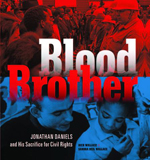 In March 1965, Jonathan Daniels, a student at Episcopal Theological School in Cambridge, Massachusetts, answered Martin Luther King’s plea to the country’s white clergy to join the Selma-to-Montgomery March. Jonathan stayed on in Alabama to work to register black citizens to vote. He was murdered on August 20, when he shielded a young black coworker, Ruby Sales, from a bullet fired by segregationist Thomas Coleman. Charged with first-degree murder, Coleman was acquitted by an all-white and all-male jury. The not-guilty verdict led to the filing of the White v. Crook lawsuit, which successfully challenged the exclusion of blacks and women from Alabama juries. This well-researched biography, which includes numerous primary source documents, including letters, newspaper articles, and captioned archival photographs, is both a tribute to civil rights activist Jonathan Daniels and an accessible introduction to this important period of the Civil Rights movement in the United States.
In March 1965, Jonathan Daniels, a student at Episcopal Theological School in Cambridge, Massachusetts, answered Martin Luther King’s plea to the country’s white clergy to join the Selma-to-Montgomery March. Jonathan stayed on in Alabama to work to register black citizens to vote. He was murdered on August 20, when he shielded a young black coworker, Ruby Sales, from a bullet fired by segregationist Thomas Coleman. Charged with first-degree murder, Coleman was acquitted by an all-white and all-male jury. The not-guilty verdict led to the filing of the White v. Crook lawsuit, which successfully challenged the exclusion of blacks and women from Alabama juries. This well-researched biography, which includes numerous primary source documents, including letters, newspaper articles, and captioned archival photographs, is both a tribute to civil rights activist Jonathan Daniels and an accessible introduction to this important period of the Civil Rights movement in the United States.
Carolyn Angus is former director of the George G. Stone Center for Children's Books, Claremont Graduate University, in Claremont, CA.
These reviews are submitted by members of the International Literacy Association's Children's Literature and Reading Special Interest Group (CL/R SIG) and are published weekly on Literacy Daily.